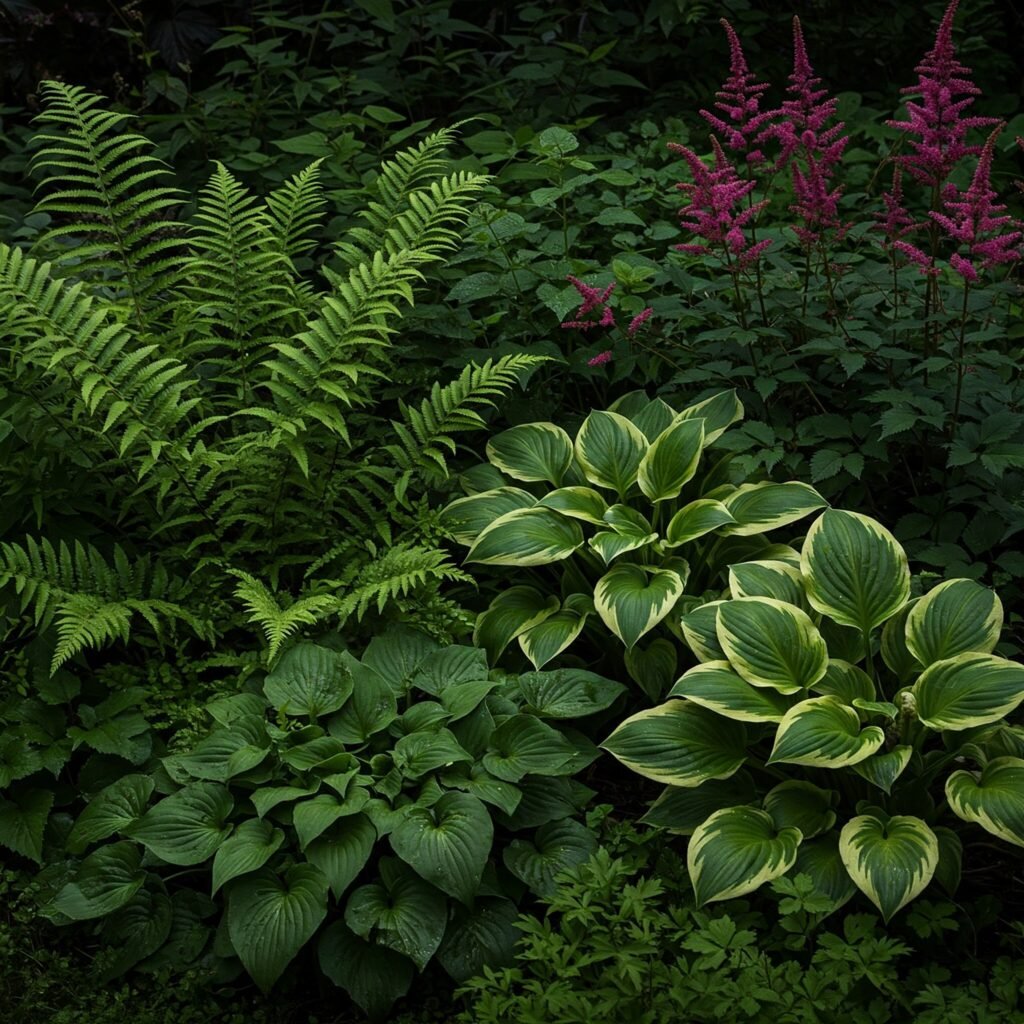Do you struggle with dark, shady spots in your yard? Shade loving plants are the perfect solution! These versatile species thrive where sunlight is limited, bringing life to forgotten corners. Unlike sun-dependent varieties, shade loving plants naturally adapt to low-light conditions, making them ideal for challenging garden spaces.
In this comprehensive guide, we’ll explore 15 exceptional shade loving plants that add color, texture, and beauty to any dim area. You’ll discover care tips, design ideas, and common mistakes to avoid when working with these low-light specialists. Whether you have a north-facing garden, a tree-covered patio, or a shady balcony, these shade loving plants will help you create a thriving green oasis.
Why Shade Loving Plants Are a Smart Choice
Not all plants need full sun to flourish. Many species naturally grow under tree canopies or in forest understories, making them perfect for shaded gardens. Here’s why you should consider them:
- Perfect for Low-Light Areas – Balconies, patios, and north-facing gardens.
- Low Maintenance – Often require less watering and pruning.
- Cooling Effect – Helps reduce heat in urban environments.
- Year-Round Interest – Evergreen varieties provide structure in winter.
Now, let’s explore the best shade loving plants for your garden.

1. Hostas – The Ultimate Shade Perennial
Hostas are a top pick for shady gardens due to their lush, textured leaves.
Why Grow Hostas?
- Variety of leaf colors (green, blue, variegated).
- Tolerates deep shade.
- Low upkeep once established.
Care Tips:
- Plant in rich, well-draining soil.
- Water deeply but infrequently.
- Protect from slugs with organic deterrents.
2. Ferns – Delicate and Air-Purifying
Ferns add a touch of woodland charm with their feathery fronds.
Best Shade-Tolerant Ferns:
- Maidenhair Fern – Graceful, fan-shaped leaves.
- Boston Fern – Ideal for hanging baskets.
- Autumn Fern – Coppery new growth.
Growing Guide:
- Keep soil consistently moist.
- Mist leaves for added humidity.
- Avoid direct sun to prevent scorching.
3. Heuchera (Coral Bells) – Vibrant Foliage
Heuchera offers stunning leaf colors, from deep burgundy to lime green.
Key Benefits:
- Long-lasting seasonal color.
- Attracts hummingbirds.
- Works in borders and containers.
Maintenance Tips:
- Plant in slightly acidic soil.
- Remove faded leaves to encourage growth.
- Divide every 3-4 years.
4. Astilbe – Feathery Plumes for Shade
Astilbe produces fluffy flower spikes in pink, white, or red.
Why Choose Astilbe?
- Blooms in late spring/summer.
- Prefers moist, humus-rich soil.
- Great for cut flowers.
Care Instructions:
- Water regularly in dry spells.
- Apply mulch to retain moisture.
- Deadhead spent blooms.
5. Bleeding Heart – Romantic Blooms
This classic perennial has heart-shaped flowers that dangle elegantly.
Growing Conditions:
- Thrives in partial to full shade.
- Dies back in summer (dormant phase).
- Returns reliably each spring.
How to Care for It:
- Keep soil evenly moist.
- Add compost in early spring.
- Shelter from strong winds.
6. Lamium – Fast-Growing Ground Cover
Lamium spreads quickly, filling empty spaces with silvery foliage.
Advantages:
- Suppresses weeds naturally.
- Drought-resistant once established.
- Attracts pollinators.
Planting Tips:
- Trim back to control growth.
- Avoid overwatering.
- Ideal for slopes and borders.
7. Caladium – Tropical Color for Shade
Caladiums boast striking, multicolored leaves that brighten dark areas.
Popular Varieties:
- White Queen – Glowing white leaves.
- Red Flash – Deep red with pink spots.
- Miss Muffet – Compact and dwarf-sized.
Care Guide:
- Plant after frost danger passes.
- Keep soil moist but not soggy.
- Store tubers indoors in winter (cold climates).
8. Hydrangeas – Big Blooms in Shade
Hydrangeas produce large, showy flowers even in partial shade.
Best Types for Shade:
- Bigleaf Hydrangea – Classic mophead blooms.
- Oakleaf Hydrangea – White flowers, red fall foliage.
- Climbing Hydrangea – Covers walls and fences.
Growing Tips:
- Water deeply weekly.
- Prune after flowering.
- Adjust soil pH for color changes (blue/pink).
9. Japanese Forest Grass – Ornamental Texture
This flowing grass adds movement to shady gardens.
Why It’s Great:
- Golden or variegated foliage.
- Soft, cascading habit.
- Deer-resistant.
Care Requirements:
- Plant in moist, well-drained soil.
- Cut back in early spring.
- Divide every few years.
10. Toad Lily – Unique Late-Season Flowers
Toad lilies bloom when most shade plants fade, offering late color.
Key Features:
- Orchid-like spotted flowers.
- Thrives in deep shade.
- Blooms late summer to fall.
Maintenance:
- Keep soil consistently damp.
- Mulch to retain moisture.
- Watch for slugs.
Bonus: 5 More Shade Loving Plants to Consider
To expand your options, here are five additional shade-tolerant plants:
11. Foamflower (Tiarella)
- Ground cover with frothy white flowers.
- Prefers moist, rich soil.
12. Brunnera (Siberian Bugloss)
- Heart-shaped leaves with silver patterns.
- Tiny blue spring flowers.
13. Solomon’s Seal (Polygonatum)
- Arching stems with dangling white blooms.
- Great for woodland gardens.
14. Ligularia (Leopard Plant)
- Bold leaves with yellow daisy-like flowers.
- Needs consistently wet soil.
15. Ajuga (Bugleweed)
- Fast-spreading ground cover.
- Blue flower spikes in spring.
How to Design a Stunning Shade Garden
A well-planned shade garden combines different heights, textures, and colors.
Design Strategies:
- Layer Plants – Tall (ferns, hostas), medium (heuchera, astilbe), low (lamium, ajuga).
- Add Contrast – Mix bold leaves (hostas) with fine textures (ferns).
- Incorporate Color – Use variegated foliage (caladiums, heuchera).
- Include Evergreens – For winter interest (hellebores, some ferns).
Common Mistakes When Growing Shade Loving Plants
Avoid these pitfalls for a thriving shade garden:
❌ Overwatering – Shady areas stay moist longer; check soil before watering.
❌ Poor Soil Prep – Enrich with compost for better growth.
❌ Ignoring Pests – Slugs and snails love shade plants; use natural deterrents.
❌ Wrong Plant Choices – Some shade plants need dappled light, not deep shade.
Final Thoughts
Shade loving plants open up endless possibilities for dark, underused garden spaces. From the dramatic foliage of caladiums to the delicate blooms of bleeding hearts, there’s a perfect plant for every shady spot.
By selecting the right varieties and following proper care, you can create a lush, vibrant garden—no direct sunlight needed!
Which shade loving plant will you try first? Share your thoughts in the comments!
